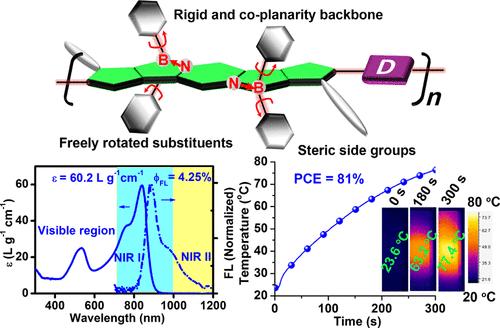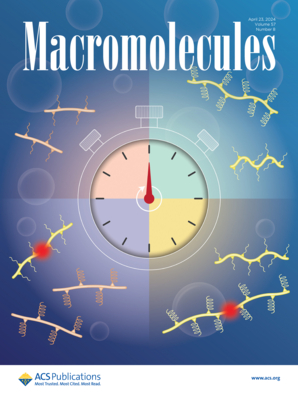Near Infrared Absorption/Emission of B ← N Embedded Polymers with Aromatic Substituents: A Judicious Balance Among Absorption Coefficient, Emission Quantum Yield, and Photothermal Conversion Efficiency
IF 5.1
1区 化学
Q1 POLYMER SCIENCE
引用次数: 0
Abstract
For semiconducting polymers (SPs) used in biomedical fields, e.g., bioimaging and photothermal therapy, three critical parameters, that is absorption coefficient (ε), emission quantum yield (ΦFL), and photothermal conversion efficiency (PCE) in near-infrared (NIR) region should be taken into account but reaching judicious balance among the three parameters is difficult. In this work, three B ← N embedded polymers, namely, BN–Cl-V, BN–Cl-S, and BN–Cl-N anchoring chlorinated phenyl as side groups with NIR absorption/emission properties, are synthesized. Due to the rigid backbone and steric substituents, these polymers not only exhibit high absorption coefficients but also maintain moderate fluorescence intensities. Moreover, high PCE values are tested owing to the free motion of phenyl side groups, which suppress the radiative transitions. Impressively, BN–Cl-V displays the highest ε of 60.2 L·g–1·cm–1, ΦFL of 4.25%, and PCE of 81% because of its best backbone coplanarity and D–A conjugation. Cytotoxicity experiments in vitro manifest that BN–Cl-V triggers more than 80% cell apoptosis under 808 nm laser irradiation (0.3 W/cm2) for 5 min. We propose an effective strategy to design SPs with balanced and satisfactory ε, ΦFL, and PCE values, which is enlightening for the preparation of polymer biomedical agents.

求助全文
约1分钟内获得全文
求助全文
来源期刊

Macromolecules
工程技术-高分子科学
CiteScore
9.30
自引率
16.40%
发文量
942
审稿时长
2 months
期刊介绍:
Macromolecules publishes original, fundamental, and impactful research on all aspects of polymer science. Topics of interest include synthesis (e.g., controlled polymerizations, polymerization catalysis, post polymerization modification, new monomer structures and polymer architectures, and polymerization mechanisms/kinetics analysis); phase behavior, thermodynamics, dynamic, and ordering/disordering phenomena (e.g., self-assembly, gelation, crystallization, solution/melt/solid-state characteristics); structure and properties (e.g., mechanical and rheological properties, surface/interfacial characteristics, electronic and transport properties); new state of the art characterization (e.g., spectroscopy, scattering, microscopy, rheology), simulation (e.g., Monte Carlo, molecular dynamics, multi-scale/coarse-grained modeling), and theoretical methods. Renewable/sustainable polymers, polymer networks, responsive polymers, electro-, magneto- and opto-active macromolecules, inorganic polymers, charge-transporting polymers (ion-containing, semiconducting, and conducting), nanostructured polymers, and polymer composites are also of interest. Typical papers published in Macromolecules showcase important and innovative concepts, experimental methods/observations, and theoretical/computational approaches that demonstrate a fundamental advance in the understanding of polymers.
 求助内容:
求助内容: 应助结果提醒方式:
应助结果提醒方式:


